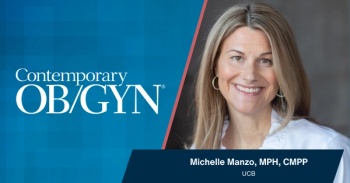
PODCAST: Sexual coercion: Moving beyond screening
Elizabeth Miller, MD, PhD, discusses her article in the February issue of Contemporary OB/GYN on sexual coercion.
Dr. Miller: I’m Elizabeth Miller and I’m the Division Chief of Adolescent and Young Adult Medicine at Children’s Hospital of Pittsburgh of UPMC.
Susan Olmstead: So Dr. Miller we’re just going to talk a little bit about your
Dr. Miller: So I talk about partner violence and sexual violence with all of my patients really using a universal education and routine inquiry approach. So it’s less about asking the right leading question as much as I say I talk to all of my patients about this with every visit.
Susan Olmstead: I see, so it’s more of a discussion rather than specific questions?
Dr. Miller: Exactly. Now if I have a patient who, as we talk about in the article where maybe they’ve come in several times requesting
Susan Olmstead: Right. Now do you think of yourself as unusual in using this approach or do you know of colleagues who use this approach as well?
Dr. Miller: So an increasing number of colleagues have shifted to this more universal education and brief counseling approach. And I think it’s for two reasons; one, is that what we have found that to rely solely on screening questions and waiting for women to check yes or to say yes, that our disclosure rates are extremely low, maybe 1 to 2%. In places where they ask more routinely about this, it may be a little bit better, maybe 10%, but that means that we see a large number of our patients who could benefit from the messages that they deserve to be treated with respect and here’s this list of resources that are available to you. Such that by shifting to a universal education approach you are much more likely to have impact for our patients. When I am interviewing women who are survivors of intimate partner violence about what they want, one of the most important requests they have of health care providers is please don’t push me to disclose to you but let me know that you care and let me know that you can connect me to help when I’m ready. Now when we really shift what our goal is in healthcare to that sensibility of “I’m here for you whenever you’re ready to talk about these issues, and if it’s not you, maybe you’ve got a friend or a loved one who you want to bring in to clinic to talk about these issues.” And that really changed the tone for us in terms of what we get to do as healthcare providers. It’s not like I’m pulling this out of a hat, it’s really based on research that I conducted and my co-author Dr. Chang has conducted showing that when we have these conversations with our patients they’re significantly more likely to use interventions, whether to call a hotline or speak with an advocate or reach out to a counselor. And that’s huge.
Susan Olmstead: It is, it is. And do you find that using normalizing language helps to draw people out as well?
Dr. Miller: Absolutely because we all recognize that there’s a stigma associated with domestic violence and with sexual violence. You know calling something rape is very difficult, in particular, when sexual violence is occurring in the context of a relationship. And so because of that the normalizing is absolutely critical. One of the things that I will say is there are many young people in our practices who are in unhealthy and sometimes dangerous relationships which is why we’re talking to everybody about this. If there’s some information that you can take along maybe you don’t need it but if there’s a friend or somebody you care about who could use this information please share it with them. And so what that does is really make sure that, it allows them to take the information because then you’re taking it not for themselves but for a friend, giving them an excuse to take the information. But it also ensures that you’re communicating that you don’t have to disclose to me, I just know that this goes on for a lot of my patients. It’s a much more trauma informed approach. Now this concept of trauma informed, I think a number of physicians are aware that many of our patients who come to see us have been exposed to various forms of interpersonal violence and that it impacts their care seeking, it impacts the kinds of problems that they come in with. And this trauma informed approached basically is saying we recognize that many of our patients have experienced trauma and we’re here to be respectful, to be non-judgmental, to be gentle in the way in which we approach you and that we have the ability to connect you to services and supports as necessary. And that shift for us away from screening and disclosure to this much more, I think a warmer and more inclusive focus on making the clinical setting a safe place for our patients who’ve experienced
Susan Olmstead: I see. So in your experience, reproductive coercion is rather common or at least interpersonal violence. As far as reproductive coercion itself, have you found that it usually takes the form of pressuring women to continue pregnancies or to end them? I thought that was very interesting.
Dr. Miller: So reproductive coercion is not only about controlling the outcomes of a pregnancy, but also pressure to get pregnant in the first place. This involves abusive male partners pressuring a woman to get pregnant when she doesn’t want to be, preventing her from using birth control, And this concept of reproductive coercion first came to my attention back when I was interviewing young women about their experiences in abusive relationships and how it has impacted their health and the very first interview I did with a young woman, she said well you know he flushed my
Susan Olmstead: Oh my goodness.
Dr. Miller: So yes, a stark reminder that this is another example of enacting power and control in that relationship, the male partner trying to have ultimate control over your body. And others where the conflict has been around wanting her to continue a pregnancy she doesn’t want to continue. Or forcing her to terminate a pregnancy she wants to continue. And so we recognize that pregnancies can be highly contested, it can be very conflicted. I totally agree that reproductive coercion is part of intimate partner violence, this whole constellation of ways in which abusive partners can enact power and control in a relationship. The reason that I have really highlighted reproductive coercion for us as clinicians is that it’s something that we can ask about directly which we have not done in the past. If we simply ask ‘Have you been hit, kicked, slapped, pushed, choked or forced to have sex against your will?,’ we are going to miss reproductive coercion. And certainly in the OB/GYN setting we’re able to offer longer acting reversible contraceptives. We’re able to offer ways to reduce her risk for a pregnancy that she doesn’t want. And a clear example of that is a copper IUD. I had one patient who we were trying to figure out what form of contraception she could use and I suggested the Depo-Provera injections. She said you know that’s not going to work because he monitors my period. And I said okay, well in which case then you may have to think about the copper
Susan Olmstead: So a patient came to you first with that?
Dr. Miller: Exactly. And it was really amazing to me that there is a survivor helping me think about what I, as a clinician, could do to reduce the risk for a pregnancy that she was not ready for. She already had two babies with this partner. It was a verbally and emotionally abusive relationship. What was so powerful was being able to offer her what I call a harm reduction strategy, reducing her risk for an unintended pregnancy, connecting her to a domestic violence advocate so she could learn more and then several years into our primary care relationship she came in one evening and said you know Dr. Miller he threw a chair at me this evening and it’s the first time he’s tried to hurt me physically and you’ve been talking to me about this for all these years and I knew you could help. And it was really, it was so powerful to know that she knew that the clinical space was where she could come to get connected to help.
Newsletter
Get the latest clinical updates, case studies, and expert commentary in obstetric and gynecologic care. Sign up now to stay informed.










